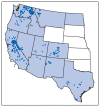Tickborne relapsing fever - United States, 1990-2011
- PMID: 25632952
- PMCID: PMC4584558
Tickborne relapsing fever - United States, 1990-2011
Abstract
Tickborne relapsing fever (TBRF) is a zoonosis caused by spirochetes of the genus Borrelia and transmitted to humans by ticks of the genus Ornithodoros. TBRF is endemic in the western United States, predominately in mountainous regions. Clinical illness is characterized by recurrent bouts of fever, headache, and malaise. Although TBRF is usually a mild illness, severe sequelae and death can occur. This report summarizes the epidemiology of 504 TBRF cases reported from 12 western states during 1990-2011. Cases occurred most commonly among males and among persons aged 10‒14 and 40‒44 years. Most reported infections occurred among nonresident visitors to areas where TBRF is endemic. Clinicians and public health practitioners need to be familiar with current epidemiology and features of TBRF to adequately diagnose and treat patients and recognize that any TBRF case might indicate an ongoing source of potential exposure that needs to be investigated and eliminated.
Figures

References
-
- CDC. Acute respiratory distress syndrome in persons with tick-borne relapsing fever—three states, 2004–2005. MMWR Morb Mortal Wkly Rep. 2007;56:1073–6. - PubMed
-
- Guggenheim JN, Haverkamp AD. Tick-borne relapsing fever during pregnancy. J Reprod Med. 2005;50:727–9. - PubMed
-
- Davis RD, Burke JP, Wright LJ. Relapsing fever associated with ARDS in a parturient woman. A case report and review of the literature. Chest. 1992;102:630–2. - PubMed
-
- CDC. Tickborne relapsing fever in a mother and newborn child—Colorado, 2011. MMWR Morb Mortal Wkly Rep. 2011;61:174–6. - PubMed
MeSH terms
LinkOut - more resources
Full Text Sources

